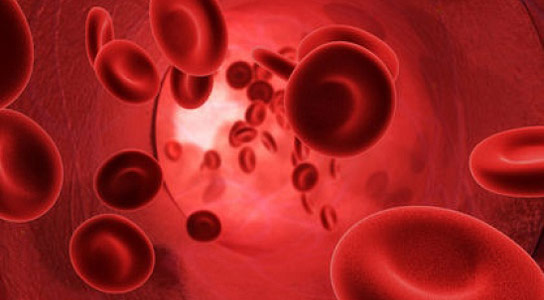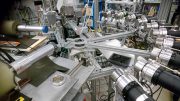
Nanodroplets with cancer medicines may one day travel through our veins. Credit: Delft University of Technology
Researchers solve a long-standing mystery of how superheated nanodroplets vaporize when hit by a pulse of ultrasound, this finding may lead to a localized and controlled form of chemotherapy.
A technique which may one day be used for tumor therapy and imaging could be greatly improved thanks to new insights obtained by scientists from the University of Twente, the Erasmus MC, and the TU Delft.
The researchers from the three universities solved a long-standing mystery of how superheated nanodroplets vaporize when hit by a pulse of ultrasound. The findings were published in Proceedings of the National Academy of Sciences.
The imaging method the team has been working on revolves around nanodroplets of a special liquid called perfluorocarbon that can be injected in a human body. These droplets can move out of the vascular system and enter the space in between the tumor cells. The idea is to activate these droplets with an intense pulse of ultrasound. This sound causes the droplets to vaporize, forming tiny bubbles of gas which can be viewed using ultrasound imaging equipment.
The same method can also be used to administer toxic medicines carried into the tumor by the droplets. This should have no damaging side effects on healthy tissue in the rest of the body, making it a localized and controlled form of chemotherapy.
The technique is still in its infancy. An important problem being the fact that the amplitude of the sound needs to be very high as to vaporize the droplets, while it may not be that high that damage may occur to healthy tissue.
What’s promising about this new research however is that it shows how the droplets can be vaporized with sound waves having just enough energy. It was known that droplets could be vaporized with sound with lower energy then the activation threshold of the droplets. But the physics behind it have been puzzling researchers for more than a decade.
Using images captured by the world’s fastest camera, the Brandaris 128, the researchers from Twente and Rotterdam were able to see that the ultrasound was being focused in a single spot within the droplet. This was peculiar, because the wavelength of the ultrasound emitted is many times larger than the droplet, causing negligible focusing.
The explanation can be found in a unique phenomenon that occurs in the propagation of ultrasound. Sound is a wave movement of high and low pressure that moves at the speed of sound. However, in the body, a high pressure propagates faster than a low pressure, distorting the wave and creating a shock wave.
“In fact, a whole series of higher harmonics develop from the original sound”, says acoustical imaging expert Dr. Martin Verweij (Applied Sciences). “The wavelength of these higher harmonics is much smaller, around the size of the droplets, and these waves can focus inside the droplet Combinations of different focusing harmonics can constructively interfere inside the droplet. The result is a localized acoustic focus with sufficient energy to vaporize the droplet.”
The focusing of the shockwaves inside the droplets was observed experimentally, yet the theory that this could destroy the droplets also needed to be proven with numerical calculations. That is where Verweij came in. “I provided the numerical method that could deal with the tiny droplets. This gave the research that last push it needed.”
Reference: “Acoustic droplet vaporization is initiated by superharmonic focusing” by Oleksandr Shpak, Martin Verweij, Hendrik J. Vos, Nico de Jong, Detlef Lohse and Michel Versluis, 21 January 2014, PNAS.
DOI: 10.1073/pnas.1312171111









Be the first to comment on "Researchers Solve a Long Standing Nano Mystery"